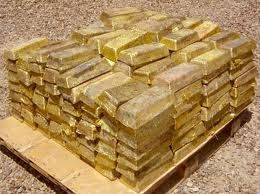by Larry
December, 2013Is It Worth It?
Buffett points out that with the money sunk in the gold cube one could buy up all the farmland in the U.S. plus umpteen of the most productive and lucrative global enterprises, and still have maybe another trillion dollars or so left for spending money, good to have for buying up bargains in an economic downturn. Every year the farmland and businesses would be keeping millions employed doing valuable work and providing untold net earnings plus hundreds of billions worth of dividends. The hunk of gold, not so much. If you had to choose, a phenomenally productive real estate, stock, and cash portfolio vs. that cube of inert heavy metal, which, he seems to suggest, would you want to have in your estate and use to create modern libraries, to fight and eradicate disease, and/or to leave to the kids? What investor in his or her right mind would pick the weighty hunk? Yet everyday thousands toil under intensely adverse conditions to add a bit more to the size of that cube. One mine in particular, South Africa's Mponeng, seems to stand in for the rest, a metaphor to gold fever and human misery. Here a whole city of underground dwellers toil and live (and maybe die) in sunless, often lawless passages for days, weeks, or longer. Mponeng encompasses over 200 miles of tunnels and has shafts that delve further into the planet than any other manmade hole. One shaft plummets to 2.5 miles beneath the surface. The temperature rises the closer one gets to Earth's molten center. The shaft walls and rocks where miners must work can be radioactive and up to 150°F. Management consumes vast quantities of ice mixed with water and salt to create a slush across which huge fans constantly blow air into the deeper parts of the mine, to keep its employees alive. By such means, the working environment is reduced to a more tolerable 85°. All this digging, cooling, and extraction effort is for a gold ore seam 30 inches wide. To assure that companies and syndicates profit from that thin section of rock, many must lead lives barely better than torture. Giving new meaning to the term underground economy, Mponeng sustains not only the legal workers who toil for meager formal wages but also ghost workers, people who live and labor there for criminal syndicates. Seeing no daylight for months at a time, their skin turns gray, and they appear ghostlike. Sometimes armed with crude bottle bombs and AK-47s, these folks occupy less used tunnels from which they break into the ones currently accessing the gold seam and steal up to 20% of the ore. They refine the rock from inside the mine, frequently using highly dangerous mercury processing methods. Since these "employees" must eat and drink while they live in the mine, they pay legal workers extravagant sums to get what they need smuggled to them. The mine's official security guards appear to have incentives to leave the ghost workers alone and look the other way. Humans are not the only species that operate profitably in these severe conditions. Extremophile bacteria (so-called because their environment is too hostile for normal life) subsist in the mine's depths as well and likely have done so for thousands if not millions of years. It may be fair then to say that, in their quest for gold and its high market (if not high practical) value, humans have both literally and figuratively descended to the depths of the bacteria. Primary sources: -Underground Cities and "Ghost" Miners: What Some People Do for Gold. Matthew Hart in NPR Books - Author Interviews; December 3, 2013; -Mponeng. in Wikipedia, the Free Encyclopedia; last updated October 12, 2013.
Too Close to the SunStudents of Greek mythology no doubt remember the story of Icarus. Daedalus, his talented craftsman father, and he were imprisoned. The father constructed wings of feathers and glue for them to use to escape. All was going well, but Daedalus had warned his son not to go too close to the sun, for then the glue would melt, and he would be destroyed. In the thrill of the moment, however, Icarus forgot his father's cautious admonitions (so easy to do when things are going great!), flew too close to the sun, lost his feathers when the glue melted, fell out of the sky, and died. The story has a sequel now, apparently, about Icarus' own son, or I-son, for, as in the essay here last month, Look, Up In the Sky!, Comet Ison on Thanksgiving Day had its closest approach to the sun ever. Scientists were eager to see what would happen. And when, after all the neat fireworks of pieces flying off and streaming out behind Ison for over ten million miles, they looked in the early morning of November 28, what to their wondering eyes did appear but: nothing at all. After an age equivalent to Earth's of orbiting about Sol from the coldest reaches of our outer solar system, the spectacular Comet Ison is no more, evidently the forecast 5000°F temperature of that nearest point in its swoon toward the sun having been too much of a good thing. Bear in mind that, for all its dramatic tails extending for millions of miles out away from the sun, Ison's diameter had only been about three miles. It was probably no larger than an Earth mountain. |
